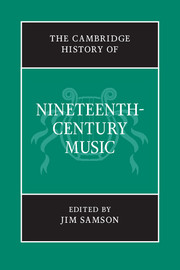Book contents
- Frontmatter
- Part One 1800–1850
- Part Two 1850–1900
- 11 Progress, modernity and the concept of an avant-garde
- 12 Music as ideal: the aesthetics of autonomy
- 13 The structures of musical life
- 14 Opera and music drama
- 15 Beethoven reception: the symphonic tradition
- 16 Words and music in Germany and France
- 17 Chamber music and piano
- 18 Choral culture and the regeneration of the organ
- 19 Music and social class
- 20 Nations and nationalism
- 21 Styles and languages around the turn of the century
- Chronology
- Institutions
- Personalia
- Index
- References
13 - The structures of musical life
from Part Two - 1850–1900
Published online by Cambridge University Press: 28 March 2008
- Frontmatter
- Part One 1800–1850
- Part Two 1850–1900
- 11 Progress, modernity and the concept of an avant-garde
- 12 Music as ideal: the aesthetics of autonomy
- 13 The structures of musical life
- 14 Opera and music drama
- 15 Beethoven reception: the symphonic tradition
- 16 Words and music in Germany and France
- 17 Chamber music and piano
- 18 Choral culture and the regeneration of the organ
- 19 Music and social class
- 20 Nations and nationalism
- 21 Styles and languages around the turn of the century
- Chronology
- Institutions
- Personalia
- Index
- References
Summary
In the sphere of art music, the second half of the nineteenth century saw the consolidation and wider dissemination of many of the structures and institutions which had been set up in Europe during the preceding decades, and which were now developing worldwide and gaining in status. Models for operatic, orchestral, educational, publishing and journalistic institutions provided by the major European centres – particularly Paris, Vienna and London – became established in the New World to the extent that cities such as Boston and New York emerged as their potential rivals on the increasingly intercontinental stage of middle-class musical life. Such consolidation took various forms: nationalist drive and the breakdown of court culture lay behind the emergence of municipal musical culture in much of what now constitutes the Czech Republic, Poland and Hungary; in North America, the ‘European’ musical traditions of cities such as New York and Boston were initiated by immigrant German musicians and embraced by a wider middle class hungry for cultural status. The pace of consolidation also varied: in France and Britain, for instance, it was leisurely in comparison with the breathless rush from urbanisation to the establishment of Europeanised cultural institutions in a new city such as Los Angeles, in which the developments of a century in Europe took place in just a few decades, starting in the 1880s. Nevertheless, the relatively late appearance of now-familiar pillars of musical life in some European cities should not be forgotten: through the entire period under consideration Paris lacked a purpose-built orchestral concert hall and Vienna a permanent civic symphony orchestra. In these areas respectively each city lagged well behind Chicago and Boston, for example.
- Type
- Chapter
- Information
- The Cambridge History of Nineteenth-Century Music , pp. 343 - 370Publisher: Cambridge University PressPrint publication year: 2001
References
- 2
- Cited by

